

Animal Rights Debate. Animal Rights Debate Animals are used for research in a variety of settings, including tests to determine the safety of drugs, cosmetics and other substances.

Whether or not humans should use animals for testing purposes, however, is a controversial subject. There are both pros and cons to using animals for testing, but the scientific community, the government and society in general have yet to reach a consensus on this ethical issue. One of the primary advantages of animal testing is that it allows researchers to develop new medications and treatments, advancing the field of medicine and enhancing the health of society. For instance, many drugs used to treat or prevent cancer, HIV, diabetes, infections and other medical maladies have resulted from tests performed on animals. Animal testing also enables scientists and researchers to test the safety of medications and other substances with which humans have regular contact. Using Stem Cells to Treat Disease" The first step in using stem cells for disease treatment is to establish stem cell lines, which researchers have accomplished.

Next, scientists must be able to turn on specific genes within the stem cells so that the stem cells will differentiate into any cell they wish. But scientists have not learned how to do this yet; so, studying stem cell differentiation is an active area of research. Once scientists can create differentiated cells from stem cells, then there are many possibilities for their use, such as drug testing and cell-based therapies. Do animals experience happiness. The American Meat Institute (AMI), a trade association of meat packers and processors, maintains a set of guidelines and standards for its members to follow in the livestock slaughtering process.
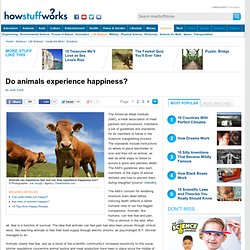
The standards include instructions on where to place electrodes to stun and then kill an animal, as well as what steps to follow to ensure a quick and painless death. The AMI's guidelines also warn members of the signs of animal distress and how to prevent them during slaughter [source: Grandin]. The AMI's concern for rendering livestock brain dead before inducing death reflects a rather humane view of our four-legged companions: Animals, like humans, can feel fear and pain. This is obvious in the wild; after all, fear is a function of survival. The idea that animals can feel pain has also been proven through clinical tests, like teaching animals to fear their food supply through electric shocks, as psychologist B.F.
Fear is an emotion that generally produces observable behavior. Lipton, Really? Testing on Animals?" Here's a little surprise about a seemingly innocent product, your everyday cup of tea: some of the world's biggest tea manufacturers engage in some pretty cruel animal testing.
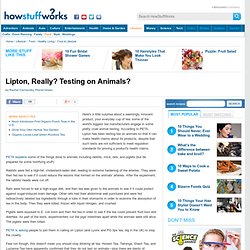
According to PETA, Lipton has been testing tea on animals so that it can make health claims about its products, despite that such tests are not sufficient to meet regulation standards for proving a product's health claims. www.howstuffworks.com/dead-animals-in-space.htm. On July 20, 1969, Neil Armstrong became the first man in history to step on the surface of the moon.
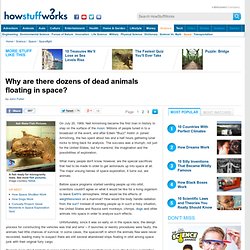
Chimpanzees as Test Subjects" Scientists selected chimpanzees as test subjects for infectious diseases with the goal of finding cures or vaccines.

For instance, the National Institutes of Health attributes ape testing to the discovery of the polio vaccine [source: Strandberg]. A decade later, when the space race between the United States and Russia blasted off, the Air Force (pre-NASA) obtained 65 chimps from the wild to research the effects of space on the body. Chimpanzee Testing" In 2000, there were around 1,600 chimpanzees in the United States being used for biomedical testing.
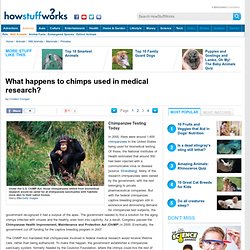
Of those, the National Institutes of Health estimated that around 500 had been injected with a communicable virus or disease [source: Strandberg]. Many of the research chimpanzees were owned by the government, with the rest belonging to private pharmaceutical companies. What happens to chimps used in medical research. If a chimpanzee could pick anywhere in the world to live, Spain would be a wise choice these days.
Not only is it a quick trip to their native Africa, but the country's parliament voted in June 2008 to support the tenets of the Great Ape Project. The nonprofit organization lobbies on behalf of great apes (chimps, gorillas, bonobos and orangutans) for their right to life, protection of individual liberty and prohibition of torture. Once the Spanish government's decision becomes law, apes cannot be held captive in circuses, for instance, or for medical testing [source: O'Carroll]. Concern regarding the ethical treatment of animals in scientific experimentation stretches back way before PETA got its start in 1980.
In 1789, philosopher Jeremy Bentham questioned whether animals possess the capacity for suffering, and Great Britain later passed its first anti-cruelty law in 1822 [source: Anderson et al]. Monkey Image Gallery. Brock Students for Animal Liberation demonstrate at the Cairns Family Health and Bioscience Research Complex (CFHBC) On Oct. 30, BSAL hosted their first demonstration of the school year that kicked off their anti-vivisection campaign.

David Burnham/ Brock Press Brock Students for Animal Liberation, formerly Brock Animal Rights Collective (BARC) had more than 20 students and supporters gather at the Cairns Family Health and Bioscience Research Complex (CFHBC) to share information and to get loud with chanting, signs and marching. As the demonstration got larger with people joining as they passed by, there were also many people who took leaflets and those who kept on walking. Community still upset with GRU animal testing. Biology freshman Hannah Kellems was so appalled when she read the media reports of the experiments this month, she began paperwork to transfer to another college.
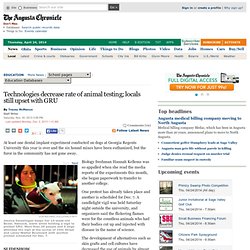
One protest has already taken place and another is scheduled for Dec. 7. A candlelight vigil was held Saturday night outside the university, and organizers said the flickering flames were for the countless animals who had their bodies cut up and injected with disease in the name of science. The development of alternatives such as skin grafts and cell cultures have decreased the use of animals by almost 50 percent over the past few decades by some estimates, but tens of millions of animals are still used in experiments and research nationwide.
3D-printed human cells could replace animal testing. News: 3D-printed human cells could replace the need for animal testing of new drugs within five years, according to a pioneering bio-printing expert at the 3D Printshow in London, which opens today.

"It lends itself strongly to replace animal testing," said bioengineering PhD student Alan Faulkner-Jones of Heriot Watt University in Edinburgh. "If it gets to be as accurate as it should be, there would be no need to test on animals. " Faulkner-Jones spoke to Dezeen while demonstrating the technology at the 3D Printshow in London this week as part of the 3D Printshow Hospital, a feature designed to showcase medical uses of 3D printing. Using a bio-printer made from a hacked MakerBot printer, Faulkner-Jones is demonstrating how human stem cells can be successfully printed to create micro-tissues and micro-organs that can be used to test drugs. As China's Policy on Animal Testing Begins to Shift, Let's Honor the Companies That Have Stood by the Animals. Last week, Cruelty Free International welcomed reports that the Chinese Food and Drug Administration has proposed to abolish the requirement for animal testing for cosmetics for domestically manufactured ordinary products (such as shampoo, skincare or perfume) from June 2014.
This is a far-reaching development that will undoubtedly spare thousands of animals from cruel tests by enabling companies to market cosmetics in China without testing on animals. While animal testing for cosmetics is legally allowed in approximately 80% of the world (including the United States), China is the only major market where animal testing is actually required for such products. This requirement has created a dilemma for companies that wanted to enter the Chinese market but were against animal testing or, at least, wanted their consumers to think that they were. China considering easing rules on animal testing for some cosmetics. China's move to minimise animal testing also signals a step forward in global commerce - Comment - Voices.
Many people don’t realise that cosmetics are still routinely tested on animals. Although cosmetic animal testing is already banned across the European Union, Israel and India, and the EU implemented an additional marketing ban this year, people are often amazed to find out that testing lipsticks, soaps and skin creams on animals remains legal in more than 80 percent of the world. Up until this announcement, which comes into force in June 2014, China was the only country in the world with mandatory animal testing requirements for domestically manufactured cosmetic products.
I have never understood why our vanity has had to be at the cost of suffering to other living things. Rabbits restrained in stocks with their eyelids forced open with clips while cosmetic chemicals are dripped into their eyes until they are blinded. Cinema Politica: Documentary Maximum Tolerated Dose looks at animal testing. Is it a “necessary evil” or an unnecessary one to use animals to test the safety of drugs? The documentary film Maximum Tolerated Dose considers that question.
It’s being shown by Cinema Politica, Monday, Nov. 4, 2013 at Concordia University. Below is an explanation of the title, a synopsis, and the trailer. “Maximum Tolerated Dose: An animal / human experiment to find the highest dose of a chemical that, when administered to a group of test subjects in a clinical trial, does not result in a fatality due to short-term toxicity. This dose is then used for longer-term safety studies of the same species, lasting anywhere from two years to a lifetime.
“Maximum Tolerated Dose is the first feature-length documentary by Decipher Films. Video of dogs going through horrid dental surgery in name of medical testing sparks outrage and protests. The Humane Society released a video last week showing dogs being used as test subjects in dental experiments at Georgia Regents UniversityUndercover video shows the dogs having their teeth pulled, replaced with implants and then euthanized to harvest jaw bone samplesWhile legal, the Humane Society says that the experiments are unnecessary By Ashley Collman Published: 14:51 GMT, 29 November 2013 | Updated: 04:48 GMT, 30 November 2013 Georgia Regents University is drawing criticism from animal rights activists who claim the school is euthanizing dogs in 'unnecessary' dental experiments.
The Humane Society posted a video last week, taken as part of a three-month undercover investigation, which shows dogs having their teeth pulled, replaced with implants and then euthanized to test bone samples. PETA Wins LUSH Prize For Public Awareness Of Animal Testing. Animals Used for Experimentation. Animal testing. Animal Rights Debate. "Fur can be worn for generations, it's organic,… Animals are killed for there fur all the time,…
Using Animals for Testing Products.